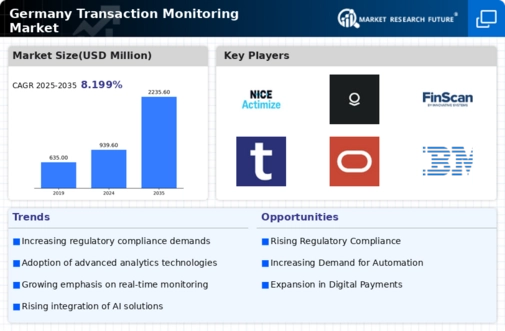Rise in Cybersecurity Threats
The transaction monitoring market in Germany is increasingly influenced by the rise in cybersecurity threats, which pose significant risks to financial institutions. Cybercriminals are employing sophisticated techniques to exploit vulnerabilities in transaction systems, leading to financial losses and reputational damage. In response, banks and financial service providers are prioritizing the implementation of robust transaction monitoring systems that can detect and prevent fraudulent activities in real-time. According to recent data, cybercrime costs in Germany are projected to exceed €200 billion annually by 2025, underscoring the urgent need for enhanced security measures. This growing concern is likely to drive investments in advanced transaction monitoring technologies, as institutions seek to safeguard their operations and maintain customer trust.
Increasing Regulatory Scrutiny
The transaction monitoring market in Germany is under heightened regulatory scrutiny, driven by the need for financial institutions to comply with stringent anti-money laundering (AML) and counter-terrorism financing (CTF) regulations. The Federal Financial Supervisory Authority (BaFin) has implemented rigorous guidelines that necessitate advanced monitoring systems to detect suspicious activities. As a result, financial institutions are investing heavily in transaction monitoring solutions to ensure compliance and avoid hefty fines. In 2023, it was reported that compliance-related costs for banks in Germany reached approximately €1.5 billion, indicating a growing demand for effective transaction monitoring market solutions. This trend is likely to continue as regulatory bodies enhance their oversight capabilities, compelling institutions to adopt sophisticated technologies to mitigate risks associated with non-compliance.
Consumer Demand for Transparency
In Germany, there is a notable shift in consumer expectations regarding transparency in financial transactions. Customers are increasingly demanding clarity and accountability from financial institutions, particularly in light of recent scandals involving financial misconduct. This trend is influencing the transaction monitoring market, as institutions strive to enhance their monitoring capabilities to provide customers with detailed insights into their transactions. A survey conducted in 2024 indicated that 75% of German consumers prefer banks that offer transparent transaction monitoring features. Consequently, financial institutions are investing in technologies that not only comply with regulatory requirements but also meet consumer expectations for transparency and trust. This evolving landscape is likely to shape the future of the transaction monitoring market, as institutions adapt to the changing demands of their clientele.
Growth of E-commerce Transactions
The transaction monitoring market in Germany is witnessing growth driven by the surge in e-commerce transactions. As online shopping becomes increasingly popular, financial institutions are faced with the challenge of monitoring a higher volume of digital transactions. This trend necessitates the adoption of advanced transaction monitoring systems capable of handling the complexities associated with e-commerce. In 2025, e-commerce sales in Germany are projected to reach €100 billion, highlighting the need for effective monitoring solutions to mitigate risks such as fraud and chargebacks. Financial institutions are therefore investing in technologies that can seamlessly integrate with e-commerce platforms, ensuring that transactions are monitored in real-time. This growth in e-commerce is likely to propel the transaction monitoring market forward, as institutions seek to enhance their capabilities in response to evolving consumer behaviors.
Integration of Artificial Intelligence
The integration of artificial intelligence (AI) technologies is transforming transaction monitoring in Germany. Financial institutions are increasingly leveraging AI to enhance their monitoring capabilities, enabling them to analyze vast amounts of transaction data more efficiently. AI-driven solutions can identify patterns and anomalies that may indicate fraudulent activities, thereby improving the accuracy of monitoring systems. In 2025, it is estimated that AI adoption in the financial sector will reach 40%, significantly impacting the transaction monitoring market. This technological advancement not only streamlines compliance processes but also reduces operational costs for institutions. As AI continues to evolve, its role in the transaction monitoring market is expected to expand, offering innovative solutions to combat financial crime.

















Leave a Comment